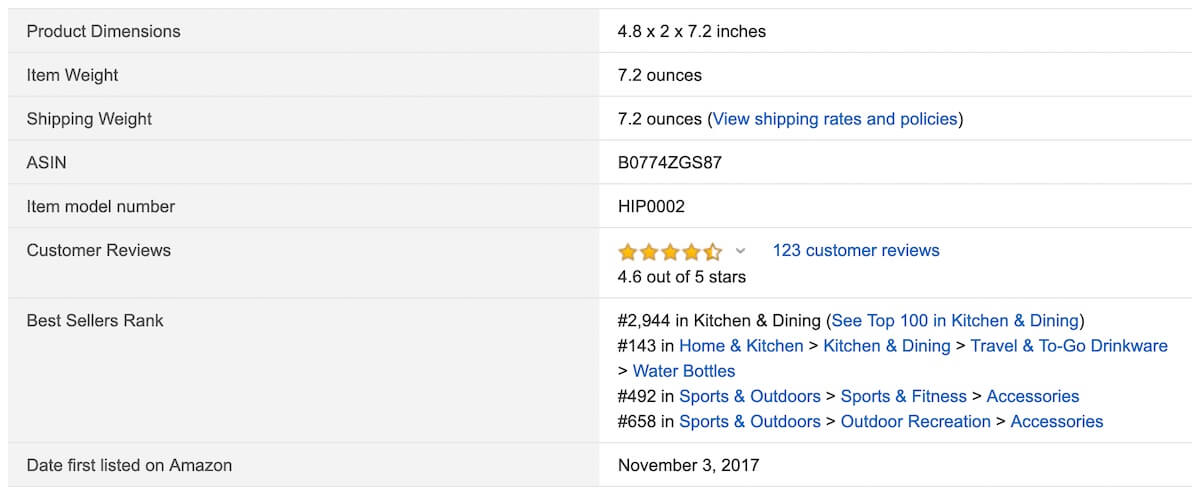
Starting any business involves a great deal of planning. Analyzing and calculating all ins and outs and building up a budget.
Starting any business involves a great deal of planning. Analyzing and calculating all ins and outs and building up a budget.
In the case of selling on Amazon and Amazon FBA, the main part is choosing the actual product that you will sell and making sure that it will perform well. Unless you see selling on Amazon as a side-job that will bring you some cash, research and planning are essential. Because you do not want to blindly invest in something that will flop.
We have compiled this research guide for Amazon to give you an idea of what is involved in this inevitable and important process.
What is Amazon Product Research?
Building a business on Amazon today is not as simple as it may seem for a newcomer. Setting up a seller account is a more or less effortless process and you can start off even without having any inventory by just selling a few items that you no longer need, like old books, for example. But sooner or later you will run out of old books to sell and you will need to find something new. That’s when product research comes into play.
Amazon product research is the process of analyzing the ongoing trends and all the data available from the marketplace to pick the niche with top demand products to bring high-volume sales. The goal is to acquire your products for the lowest price available and then sell those with the highest profit ratio possible.
Product research is an essential part of private labeling which is the method of selling products that you produce and distribute under your own brand.
Over the years, private label selling has become the most widely used method of selling on Amazon because it proved to be a success. And product research has become a very complicated process that involves many steps.
Why is Product Research Important?
Amazon operates about 3 billion different products worldwide and more than half a billion of them are sold on the US website. With such a wide range of products on the marketplace and their sheer amount, there are a lot of variables involved in selecting the best products for selling. Superficial calculation of possible margins just does not cut it.
After you select the item, you need to find a supplier, make an order (almost always in bulk), pay the money, ship the products to Amazon or your warehouse. That is when, hopefully, the item will become a success and will generate a lot of orders and sales. Unless your pockets are quite deep, you cannot afford to make the mistake of selecting the wrong product to sell.
How to do Basic Amazon Product Research?
Following are some basic strategies for finding the Right Product:
1. Try to be creative
Do you have the eye for inventions and innovation? Do you already use some product that you think can do with some improvement? If so, you can start by actually taking this product and making it better. Then find a manufacturer who can bring these improvements into life. You can test your ideas with a focus group of your friends and family.
2. Do your keyword research
Finding a keyword that will increase listing visibility is a very important step not only for product research but for selling on Amazon in general. There is a huge number of tools on the market created specifically for keyword research, like Jungle Scout, Helium 10, or SellerApp. The main point of finding what people look for on Amazon is to find your niche. For instance, you see that thousands of people run searches for a particular keyword. But the top items that dominate the search results generate just dozens of orders. That means that people actually do not find what they look for on Amazon. And that might be the market that is worth exploring.
3. Improve your future listings
If you check for competitors and find that their products sell well but the product listings are not up to standard this is your chance. You can create better listings and have your products rank higher. For some ideas on listing optimization check this article.
Key Features to Look for in a Product
Here are some general guidelines for selecting a product to sell on Amazon. The power features of a high-volume selling product are:
1. Impulse purchase price range
As a beginner, you want to look for products with the price between $50-100. Firstly, the initial cost of producing and the shipping cost of such products is much lower. Plus, it is unlikely that customers will do much of a comparison before buying an inexpensive product or have to consult with their spouse, for instance, as opposed to a more expensive purchase.
2. Small and light
Go for products that are not bulky or slow-moving. This will give you the opportunity to save on shipping costs and avoid the hidden fees with FBA. Amazon charges more for processing bigger items. Additionally, there is a fee for long-term storage of slow-moving items that you also want to avoid.
3. Bestseller rank (BSR)
To find a product that sells often go to Amazon’s best sellers page. It can give you an idea about how high the demand is for this particular item on the market.
If you are a beginner, go for items that have BSR of 5000 or lower. To find the actual BSR of a product, check the Product Details in the description. The main focus is on the number that comes first, this is the product’s rating in the main category. On the screenshot below it is “Kitchen & Dining”.
Going for products that are already popular with customers is a great way to gain momentum from the beginning. As a beginner, do not try to chase products with a BSR below 1000 as it is sure to be populated by more experienced sellers with great ratings.
4. Stable demand
For beginners in general, it is better to avoid selling seasonal products. Festive seasons are a highly competitive time, a lot of sellers want their share of the sales and you will risk not selling your inventory and getting stuck with unwanted items for the rest of the year. Look for the items that generate a good amount of sales throughout the year.
No need to say that seasonal products are not profitable at all and should be avoided at all costs. To be exact, investing in nothing more than seasonal products can be pointless. Again, you need to find something that will work for you and try to calculate all outcomes.
Mistakes and Products to Avoid
1. Complicated or fragile items
The fragile part speaks for itself. First of all, the packaging for such products requires special consideration and naturally more money. Additionally, if you sell on Amazon FBA, you do not have any say in how your products are shipped and packaged, so it might result in the overall time or money loss. Overly complicated items might also become a headache, especially during the stages of production.
2. Undifferentiated products
These are products that a customer can easily substitute for a similar product from another supplier. The items that you sell on Amazon need to stand out. So, unless you can offer a great price or have the top seller ratings, find products that are not identical to others.
3. Taking on too much competition
When you get an idea of an item that you want to sell, check how many merchants on Amazon sell similar items. Do not opt for niches that are already over-saturated with other offers. ? It will be hard to stand out among the competitors and your new listings might just drown on the last pages of search results because they do not have any reviews.
4. Not calculating margins or setting too low price
If you do not keep track of the ratio between your margins and Amazon’s fees you will lose money. The same goes for deciding to set up a lower price to stand out from your competitors. This way you just put yourself in the disadvantaged position from the start.
How to Get the Most out of Your Amazon Product Research
The first thing you need to understand is – what people are willing to spend their money on and how many customers are ready to buy a product you are going to sell.
No one seeks to sell items that people (potential buyers) are not even searching for. Experienced sellers are aimed at products that have a great opportunity, demand, are highly searched for, and are targeted at the needs of a wide audience.
What’s important while doing your product research for Amazon is to have a list of key metrics:
1. Product Price
It is best to pick the low-/ mid-level product price range that doesn’t exceed $50. As a rule, customers do not spend a lot of time searching for the best sellers at this price range. They are likely to make impulsive purchase decisions, which gives you a significant advantage.
2. Reviews & Best Seller Rankings
Reviews are free tools for research that say a lot about a product. And we do not mean here grateful comments or compliments to the Amazon seller (although – these are important as well)… It is more about the number of customer reviews – they can help you understand how projected the niche is and how easy it will be for you to climb to the top positions. By the way, customer reviews on Amazon give you a great opportunity to identify weak points in your competitors and get them fixed in the products you are going to sell. It is a win-win strategy – believe us.
The best seller rank (BSR) parameter (that we already mentioned above) will help you understand how in-demand the product is and how well it is sold within its respective category. Defining a couple of products with a BSR ranking of 5,000 in the main category, you will get an idea of your main competitors. It is also a good way to determine your chances of success in a particular trading segment.
3. Keywords and Search Queries
One of the most powerful research tools in assessing customer interest in your product is measuring its search volume on Amazon, Google, or Yahoo. First, you should get a list of high-frequency keywords related to your product. You can outline them yourself or check what your main competitors use for online promotion. Finding a product with targeted keyword search rates at the level of 1,000+ per month is a good-to-go direction.
4. Demand & Sales Volume
It is doubtful that you are ready to go for a product that is only sold (popular) a couple of weeks/ months a year. This business decision will never make you a successful entrepreneur. Therefore, you should check whether there is a year-round demand for your projected Amazon product while doing the research.
The most effective way to do that is to go to Google Trends research tool and submit a primary keyword in the search string. As a result, you will get a graph reflecting the search volume on different days and months of the year. It really is not difficult to determine whether a product is seasonal by the graphs you’ll get.
As for sales volume – experienced traders say that it is better to pick a product that is currently sold in a quantity of no less than 10 items per day. Obviously, the higher the daily average sales volume, the greater profits you will get.
5. Competitors’ Authority
It is extremely difficult to compete with big brands. You will either need to decrease a price and sell a product almost for free for a couple of months or be ready to quit the market at the very beginning. People always give preference to famous brands and compared to an unknown company or trader. Therefore, it is way better to choose business niches with minimal branded competition rates.
6. Shipping Costs
You should always keep in mind shipping costs; otherwise, you will end up in a situation when you are selling a low-price Amazon product whose shipping cost significantly exceeds the original price. It is highly unlikely that people go online to buy such items. In practice, it is best to go for products under 2-3 pounds.
How to Come Up with Product Ideas
It is relatively easy to verify a product’s demand with a specialized research tool if you know the product you want to sell; all you need to do is to assess the projected demand and popularity of the item to be sold (of course, you’ll have to pay for these).
The situation is somehow different when you have no clue of the direction to follow. If it is the case of yours, here are some useful tips that will help you map out countless product opportunities.
Tip 1 – 999 Method
It is another trick in the book that might help in the later stages of selection. Namely, it can show how well some particular product performs with your competitors. Although, it is quite a known move in the industry it can still be useful.
There are a few steps:
- Identify your competitors and among their listings find the product that you plan to sell.
- Add the product to the shopping cart.
- In the cart change the quantity to “10+” and then to 999.
- Then you might see the message that will tell you that “Only 149 items are available from that seller”, for example.
- Remember this number and repeat the process after a week or so.
This way you can check how many items were sold within some period of time. This can give you the general idea about what you can count on when selling the product yourself.
You will need to do this with every competitor to get more exact data. Unfortunately, this will not work for any item or any competitor because some sellers set up a maximum number of items that you can add to cart.
Tip 2 – Keep an Eye on BSR Changes
You should always start tracking interesting products whose number of sales has grown up recently. Checking the products whose BSR (best seller rating) has significantly boomed in the past 24 hours is a good way of defining your possible leaps and getting some improvement ideas from other sellers. Further steps of your analysis can help you define what you can do to make your listing better.
Tip 3 – Check New Arrivals and Trending Products
Your aim is to know what is popular and is being sold best at the moment. Check out for hot new releases and trending products to outline key purchase patterns and customer needs. It is also a good way to outline gaps in the market that you can cover with your best-selling propositions.
Tip 4 – Get to Know the Most Wished Products
Knowing what products your potential buyers add to their wish lists and consider the most gifted is a half of success. Thus, you will get an idea of what’s important to people and what they are ready to pay for. If you map out the trading niches with great profit margins and low competition, then you will get a well-refined list of products that will “perform” at max during the holiday season.
Tip 5 – Check What People Search for
It is also important to analyze the most frequent buyer’s search queries. This information will help you identify the most promising trading directions for your business. Check keyword search volume and their monthly usage to know the user interest, product seasonality, average price, and the competition level.
Tip 6 – Keep in Mind Customer Needs
You can easily get to the top-selling positions with your product if you cater to the buyer’s needs. Ask yourself the following questions to understand if there is a demand for this product:
- What is this Amazon product for? Can a user easily find information about it?
- What makes your product stand out from the crowd, and is it obvious to buyers?
- How do similar products perform on the market? What customer reviews and ratings do they have?
- Are there any gaps in similar products that you can use for your benefit?
- Is there any product (accessory) to be used together or complement the already sold item?
Extra Tip – Don’t Forget to Optimize Listings
To remain in the top positions your main goal is to make sure that people get all the necessary information in your listings – from well-structured production descriptions to real photos. So if there is no product image or information on important product specs, you will most likely go down in ratings.
The above data will help you map out your seller’s opportunities and find a niche that will be in high demand with buyers. For any product on Amazon, you can easily find similar items typically brought along with it, thus, get even more product ideas!
Was this news helpful?








 Yes, great stuff!
Yes, great stuff! I’m not sure
I’m not sure No, doesn’t relate
No, doesn’t relate



